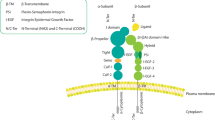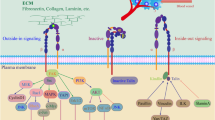Abstract
CNTO 95 is a fully human monoclonal antibody that recognizes αv integrins. Previous studies have shown that CNTO 95 exhibits both anti-tumor and anti-angiogenic activities (Trikha M et al., Int J Cancer 110:326–335, 2004). In this study we investigated the biological activities of CNTO 95 on breast tumor cells both in vitro and in vivo. In vitro treatment with CNTO 95 decreased the viability of breast tumor cells adhering to vitronectin. CNTO 95 inhibited tumor cell adhesion, migration, and invasion in vitro. CNTO 95 treatment also induced tyrosine dephosphorylation of focal adhesion kinase (FAK), and the docking protein paxillin that recruits both structural and signaling molecules to focal adhesions (Turner CE, Int J Biochem Cell Biol 30:955–959, 1998; O’Neil GM et al., Trends Cell Biol 10:111–119, 2000). These results suggest that CNTO 95 inhibits breast tumor cell growth, migration and invasion by interruption of αv integrin mediated focal adhesions and cell motility signals. In vivo studies of CNTO 95 were conducted in an orthotopic breast tumor xenograft model. Treatment with CNTO 95 resulted in significant inhibition of both tumor growth and spontaneous metastasis of MDA-MB-231 cells to the lungs. CNTO 95 also inhibited lung metastasis in a separate experimental (tail vein injection) model of metastasis. The results presented here demonstrate the anti-tumor and anti-metastatic activities of CNTO 95 in breast cancer models and provide insight into the cellular and molecular mechanisms mediating its inhibitory effects on metastasis.







Similar content being viewed by others
References
Hynes RO (2002) Integrins: bidirectional, allosteric signaling machines. Cell 110:673–687
Juliano RL, Reddig P, Alahari S, Edin M, Howe A, Aplin A (2004) Integrin regulation of cell signalling and motility. Biochem Soc Trans 32:443–446
Kageshita T, Hamby CV, Hirai S, Kimura T, Ono T, Ferrone S (2000) Differential clinical significance of alpha(v) Beta(3) expression in primary lesions of acral lentiginous melanoma and of other melanoma histotypes. Int J Cancer 89:153–159
Arihiro K, Kaneko M, Fujii S, Inai K, Yokosaki Y (2000) Significance of alpha 9 beta 1 and alpha v beta 6 integrin expression in breast carcinoma. Breast Cancer 7:19–26
Markovic-Lipkovski J, Brasanac D, Muller GA, Muller CA (2001) Cadherins and integrins in renal cell carcinoma: an immunohistochemical study. Tumor 87:173–178
Goldberg I, Davidson B, Reich R, Gotlieb WH, Ben-Baruch G, Bryne M, Berner A, Nesland JM, Kopolovic J (2001) Alphav integrin expression is a novel marker of poor prognosis in advanced-stage ovarian carcinoma. Clin Cancer Res 7:4073–4079
Kawashima A, Tsugawa S, Boku A, Kobayashi M, Minamoto T, Nakanishi I, Oda Y (2003) Expression of alphav integrin family in gastric carcinomas: increased alphavbeta6 is associated with lymph node metastasis. Pathol Res Pract 199:57–64
Sato T, Konishi K, Maeda K, Yabushita K, Miwa A (2003) Integrin alpha v, c-erbB2 and DNA ploidy in lung metastases from colorectal cancer. Hepatogastroenterology 50:27–30
Cooper CR, Chay CH, Pienta KJ (2002) The role of alpha(v)beta(3) in prostate cancer progression. Neoplasia 4:191–194
Hapke S, Kessler H, Luber B, Benge A, Hutzler P, Hofler H, Schmitt M, Reuning U (2003) Ovarian cancer cell proliferation and motility is induced by engagement of integrin alpha(v)beta3/Vitronectin interaction. Biol Chem 384:1073–1083
Stupack DG, Cheresh DA (2004) Integrins and angiogenesis. Curr Top Dev Biol 64:207–238
Wittekind C, Neid M (2005) Cancer invasion and metastasis. Oncology 69(Suppl 1):14–16
Bartsch JE, Staren ED, Appert HE (2003) Adhesion and migration of extracellular matrix-stimulated breast cancer. J Surg Res 110:287–294
Vacca A, Ria R, Presta M, Ribatti D, Iurlaro M, Merchionne F, Tanghetti E, Dammacco F (2001) Alpha(v)beta(3) integrin engagement modulates cell adhesion, proliferation, and protease secretion in human lymphoid tumor cells. Exp Hematol 29:993–1003
Parsons JT (2003) Focal adhesion kinase: the first ten years. J Cell Sci 116:1409–1416
Parsons JT, Martin KH, Slack JK, Taylor JM, Weed SA (2000) Focal adhesion kinase: a regulator of focal adhesion dynamics and cell movement. Oncogene 19:5606–5613
Mitra SK, Hanson DA, Schlaepfer DD (2005) Focal adhesion kinase: in command and control of cell motility. Nat Rev Mol Cell Biol 6:56–68
Turner CE (2000) Paxillin interactions. J Cell Sci 113(Pt 23):4139–4140
Trikha M, Zhou Z, Nemeth JA, Chen Q, Sharp C, Emmell E, Giles-Komar J, Nakada MT (2004) CNTO 95, a fully human monoclonal antibody that inhibits alphav integrins, has antitumor and antiangiogenic activity in vivo. Int J Cancer 110:326–335
Veryard C (2006) AACR-NCI-EORTC–17th symposium: molecular targets and cancer therapeutics. 14–18th November 2005, Philadelphia, PA, USA. IDrugs 9:1–3
Atienza JM, Zhu J, Wang X, Xu X, Abassi Y (2005) Dynamic monitoring of cell adhesion and spreading on microelectronic sensor arrays. J Biomol Screen 10:795–805
Hood JD, Cheresh DA (2002) Role of integrins in cell invasion and migration. Nat Rev Cancer 2:91–100
Aznavoorian S, Stracke ML, Parsons J, McClanahan J, Liotta LA (1996) Integrin alphavbeta3 mediates chemotactic and haptotactic motility in human melanoma cells through different signaling pathways. J Biol Chem 271:3247–3254
Voura EB, Ramjeesingh RA, Montgomery AM, Siu CH (2001) Involvement of integrin alpha(v)beta(3) and cell adhesion molecule L1 in transendothelial migration of melanoma cells. Mol Biol Cell 12:2699–2710
Frame MC (2004) Newest findings on the oldest oncogene; how activated src does it. J Cell Sci 117:989–998
Turner CE (1998) Paxillin. Int J Biochem Cell Biol 30:955–959
O’Neill GM, Fashena SJ, Golemis EA (2000) Integrin signalling: a new Cas(t) of characters enters the stage. Trends Cell Biol 10:111–119
Schlaepfer DD, Mitra SK, Ilic D (2004) Control of motile and invasive cell phenotypes by focal adhesion kinase. Biochim Biophys Acta 1692:77–102
Price JE, Polyzos A, Zhang RD, Daniels LM (1990) Tumorigenicity and metastasis of human breast carcinoma cell lines in nude mice. Cancer Res 50:717–721
Tucker GC (2006) Integrins: molecular targets in cancer therapy. Curr Oncol Rep 8:96–103
Hanks SK, Ryzhova L, Shin NY, Brabek J (2003) Focal adhesion kinase signaling activities and their implications in the control of cell survival and motility. Front Biosci 8:d982–d996
Tilghman RW, Slack-Davis JK, Sergina N, Martin KH, Iwanicki M, Hershey ED, Beggs HE, Reichardt LF, Parsons JT (2005) Focal adhesion kinase is required for the spatial organization of the leading edge in migrating cells. J Cell Sci 118:2613–2623
Brown MC, Cary LA, Jamieson JS, Cooper JA, Turner CE (2005) Src and FAK kinases cooperate to phosphorylate paxillin kinase linker, stimulate its focal adhesion localization, and regulate cell spreading and protrusiveness. Mol Biol Cell 16:4316–4328
Cohen LA, Guan JL (2005) Mechanisms of focal adhesion kinase regulation. Curr Cancer Drug Targets 5:629–643
McLean GW, Carragher NO, Avizienyte E, Evans J, Brunton VG, Frame MC (2005) The role of focal-adhesion kinase in cancer - a new therapeutic opportunity. Nat Rev Cancer 5:505–515
Sein TT, Thant AA, Hiraiwa Y, Amin AR, Sohara Y, Liu Y, Matsuda S, Yamamoto T, Hamaguchi M (2000) A role for FAK in the Concanavalin A-dependent secretion of matrix metalloproteinase-2 and -9. Oncogene 19:5539–5542
Schaller MD (2004) FAK and paxillin: regulators of N-cadherin adhesion and inhibitors of cell migration? J Cell Biol 166:157–159
Acknowledgements
We thank Paul Marsters for his help in statistical analysis and Ray Heslip for his help preparing graphs.
Author information
Authors and Affiliations
Corresponding author
Rights and permissions
About this article
Cite this article
Chen, Q., Manning, C.D., Millar, H. et al. CNTO 95, a fully human anti αv integrin antibody, inhibits cell signaling, migration, invasion, and spontaneous metastasis of human breast cancer cells. Clin Exp Metastasis 25, 139–148 (2008). https://doi.org/10.1007/s10585-007-9132-4
Received:
Accepted:
Published:
Issue Date:
DOI: https://doi.org/10.1007/s10585-007-9132-4




